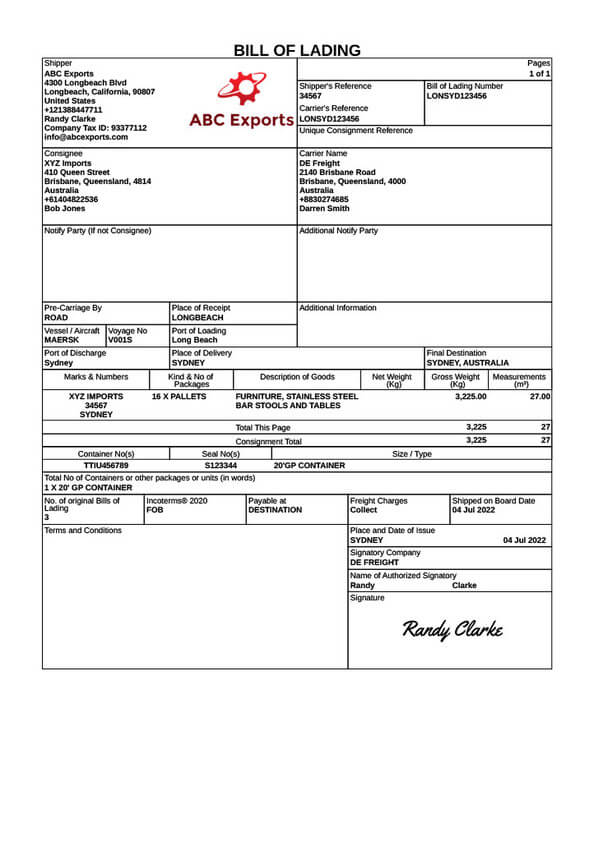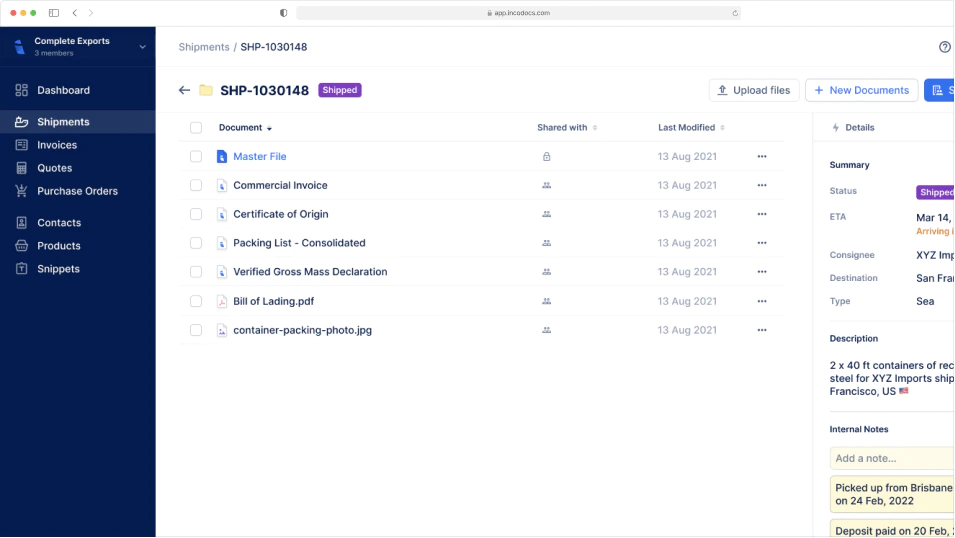IncoDocs raises $1.2M seed round led by Maersk GrowthRead the announcement

Bill of Lading Template
What is a Bill of Lading used for?
A Bill of Lading (BOL) is a legal document used in freight shipments across all modes of transportation. It serves three key roles: Evidence of contract of carriage It shows the agreement between the shipper, carrier, and consignee. This contract outlines the terms and conditions for moving the cargo. Receipt of goods The BOL acts as proof that the shipping company received the shipment in good condition. It includes key shipment details, such as the container number, description of goods, and any special instructions. Document of title to the goods The holder of the bill has the right to claim or transfer ownership of the cargo. The shipper may hold the document until payment is made to avoid early release to the recipient. *Only the consignee listed on the Bill of Lading has contractual rights to request the release of the cargo.
How to create a Bill of Lading
Open IncoDocs
Open IncoDocs in your browser and navigate to the “Export Docs” section.
Choose the Bill of Lading template
Click on 'New document set' and select the Bill of Lading template along with any other export documents you wish to create.
Fill out & customize your doc
Fill out the document, customize template fields to your needs and add your company letterhead. To save time and prevent re-entry errors, enter key shipment data into the Master File to have it sync across all other documents in your set automatically.
Sign & seal
Click on the signature box at the bottom of your document to create and place a digital signature then hit “Save & Quit”. On the document preview screen, click on the ‘More’ dropdown button and select “Add company seal” to place a digital stamp.
Download or share
Download or share documents from IncoDocs in 1-click. Documents can be downloaded as PDF or CSV which can be imported into other systems without manual re-entry.
Your questions, answered.
Types of Bill of Lading Documents
There are many types of Bill of Lading documents and formats that carriers can issue along the supply chain. Below are a few examples of B/L types:
House Bill of Lading
Surrender Bill of Lading
Straight Bill of Lading
Master Bill of Lading
Blank Bill of Lading
What is the difference between Freight Collect and Freight Pre-Paid?
A Bill of Lading shows if freight charges are Freight Collect or Freight Prepaid. This tells who is paying for international shipping.
The carrier must receive payment before releasing the cargo to the consignee.
Freight Collect Incoterms® include – EXW, FCA, FAS, FOB
Freight Pre-Paid Incoterms® include – CFR, CIF, CPT, CIP, DAP, DPU, DDP
What information is included on a Bill of Lading Document?
Who issues a Bill of Lading?
A Bill of Lading is created when goods are loaded for transport. It confirms that the carrier has taken possession and outlines the agreed shipping terms. The document shows who arranged the shipment, who receives the goods, and how they move between locations.
These parties may issue or prepare the BOL:
Each BOL includes shipment information like cargo type, transport mode, consignee name, and special terms. The layout may change depending on the country, cargo type, or shipping agreement.
What is the penalty for the late filing of Bill of Lading?
Late filing of a Bill of Lading under the Importer Security Filing (ISF) rules can lead to fines. This applies to shipments entering the United States.
First-time violations may be reduced to $1,000–$2,000 depending on the case. Repeat offences can cause cargo delays or extra inspections.
To avoid fines, importers should file ISF documents on time. Using a customs broker or an automated filing system helps keep things on track and reduces the risk of errors.
Are a Bill of Lading and a Packing List the same?
No, they are not the same. A Bill of Lading is a legal contract between the shipper, consignee, and carrier. It acts as proof of cargo receipt, outlines transport terms, and can serve as a title document.
A Packing List shows what is inside the shipment. It lists the items, quantities, weights, and packaging details. It does not serve as a contract or title and is not used to transfer cargo ownership.
Both are used together in international shipments but serve different roles in logistics and customs clearance.
What’s the difference between a Packing List and a Bill of Lading?
A Packing List is a detailed document that shows what is inside the shipment. It includes item names, quantities, weights, and how goods are packed. It helps customs, warehouse staff, and the buyer check the contents during handling.
A Bill of Lading is a legal document from the carrier. It confirms receipt of the goods and establishes the terms of delivery. It also acts as a contract of carriage and can show who owns the cargo.
The Packing List shows what is being shipped. The Bill of Lading shows how and under what terms the cargo is moved. Both are used in export shipments but serve different roles.
Is the Bill of Lading template free?
Yes, you can use the Bill of Lading template for free on IncoDocs. Just sign up for a free account to create, edit, and download your BOL. The template includes all key shipment details and works for international freight. You’ll also gain access to additional export documents, such as commercial invoices and packing lists.
Free to start,
Easy to use.
Setup in 5 mins.
